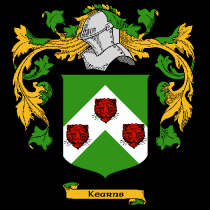|
 Kearns Kearns
As you
can see I have my family crest above. So in case any one has
any query my family comes from County Limerick. My family came
to County Limerick from County Clare. They settled some of the
settle in a small village called Shanagolden and more of them
went to America. Here is some more information about the name
Kearns .The sept known in Irish as O Ceirin was in early times
in possession of the greater part of the present barony of Costello,
Co. Mayo, of which their chiefs were paramount. During the mediaeval
period they gradually became reduced in importance, though they
remained in their native habitat in a more or less subordinate
position and also spread into the neighbouring counties. an
inquisition of 1609 describes them as then erenaghs of Killaghtee,
in the diocese of Raphoe; and in the census of 1659 we find
them in Co. Sligo. It is in Co. Mayo they are still numerous
to-day. This Mayo sept anglicized their name Kearns. In Donegal
it is sometimes Kerr to-day. An
influential branch of it settled in Co. Clare about the year
1420. They prospered in their new home and have been prominent
in Co. Clare since then. The anglicized form of the surname
of this branch is Kerin or O'Kerin. The tomb of Teige O'Kerin
(1685) is still to be seen in Ennis Abbey. Kearon in Wicklow
and Kerrane in Mayo are other variants of the name.
The
three best known men of the name were in fact none of them from
Co. Mayo or Co. Clare. Father Moses Kearns, the intrepid leader
in Co. Wexford in 1798, was executed in that year; a decade
earlier he had been hanged from a lamp post in Paris by the
revolutionary mob, but survived through the breaking of the
rope and the fortunate presence of an Irish doctor. William
Henry Kearns (1764-1846), a Dublin man, was a noted violinist,
organist and composer. Richard Kerens (1842-1916), American
Railroad builder, was the son of a Kearns from Co. Meath.
|